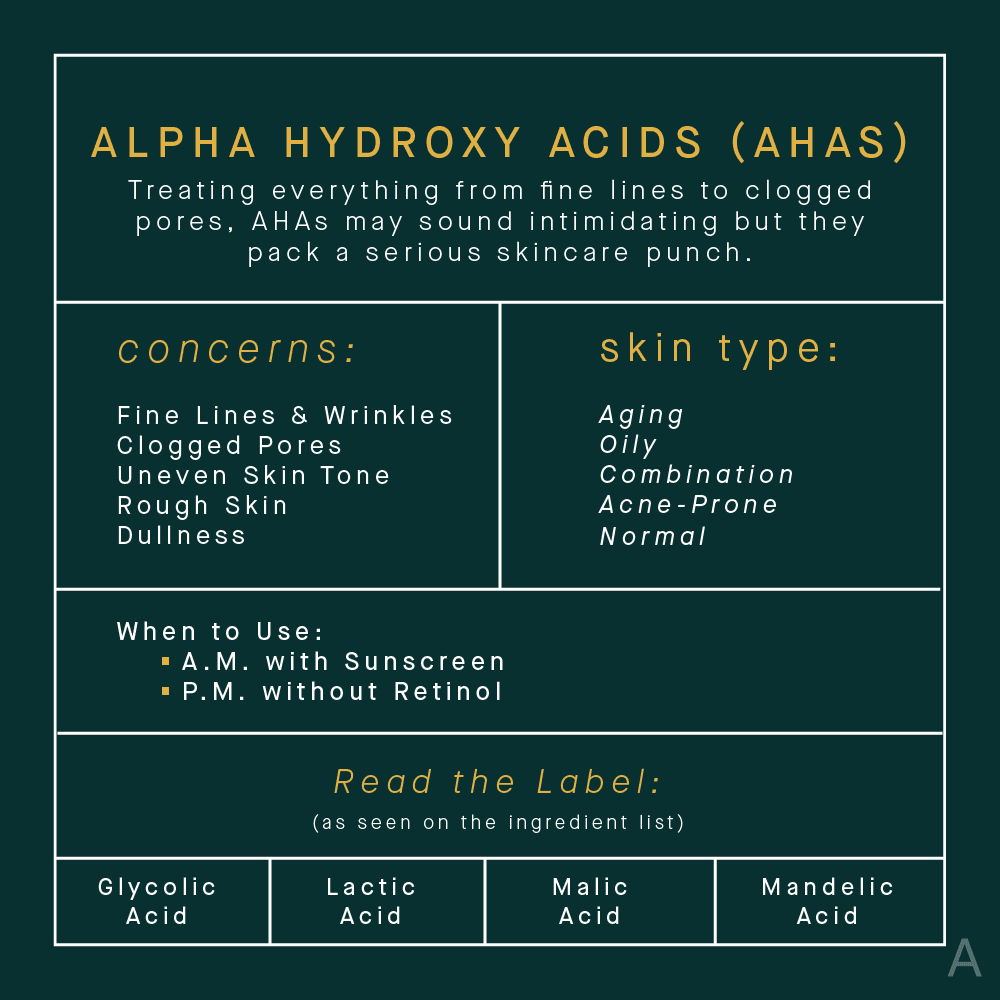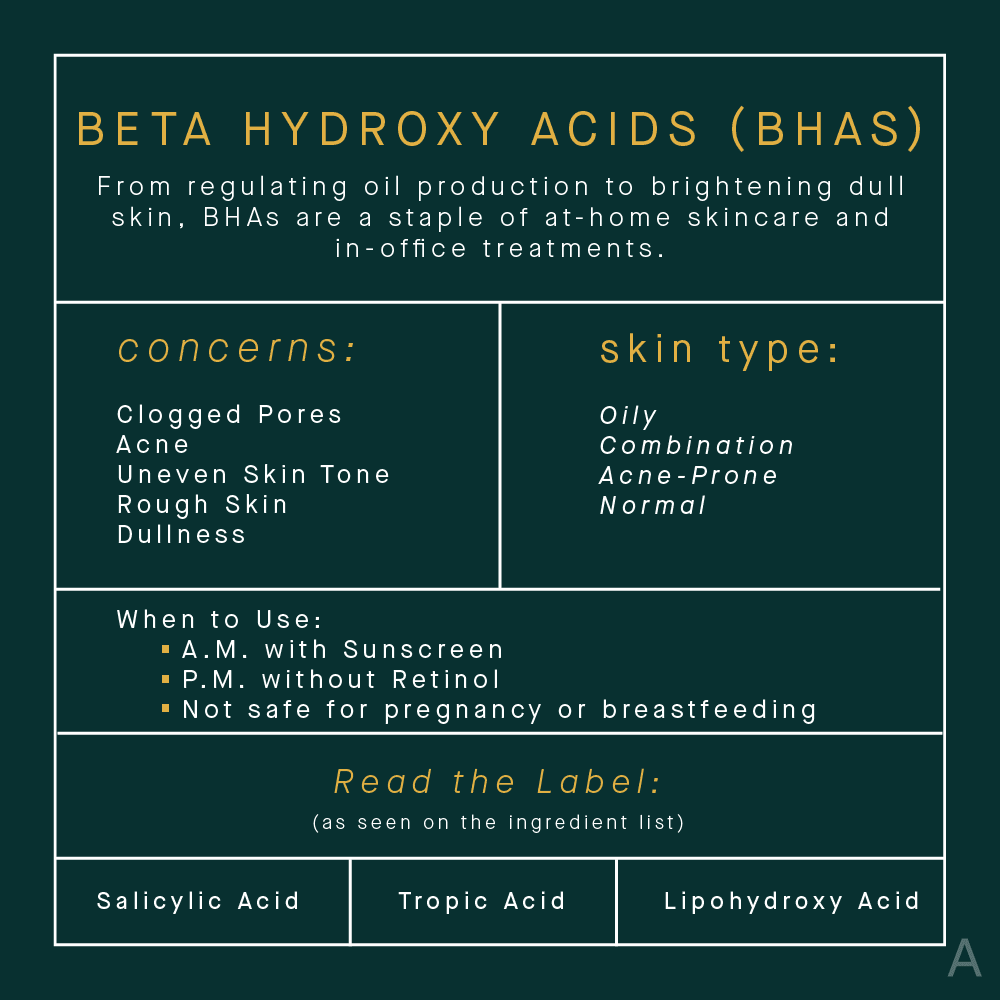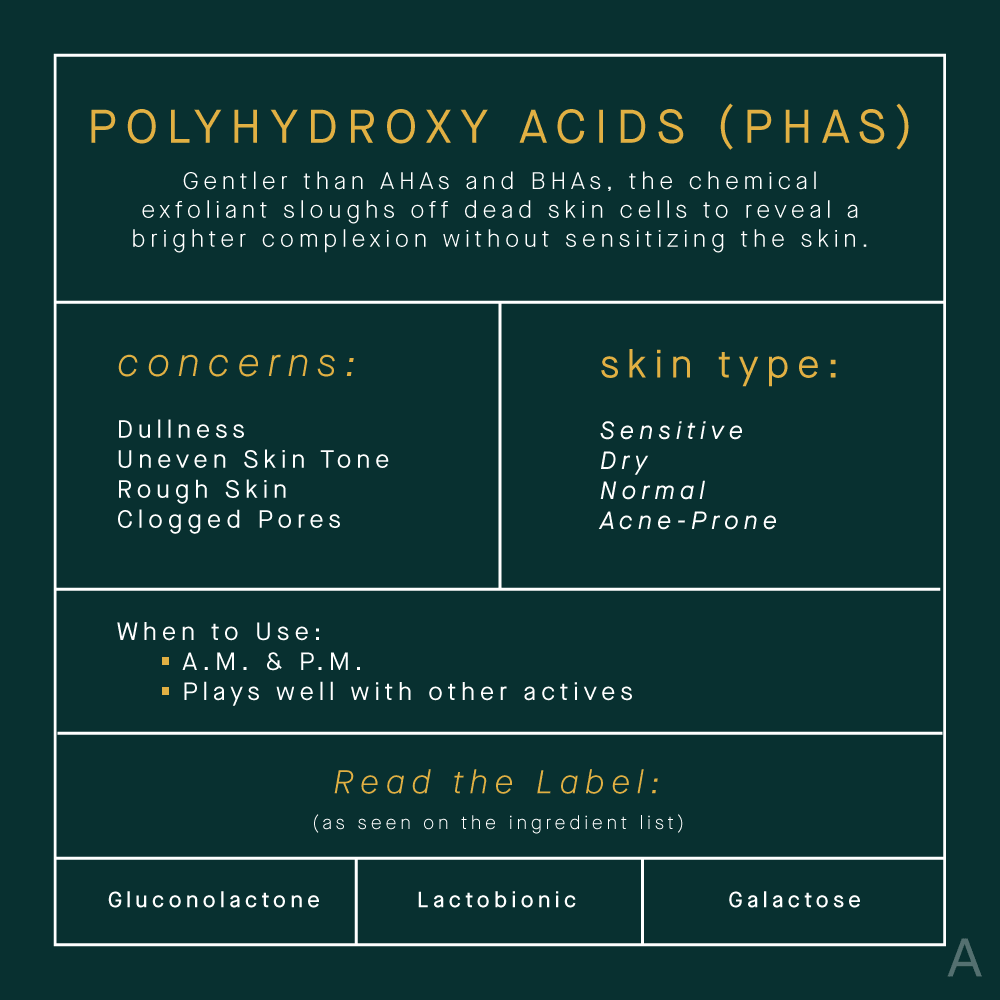 Glycolic Peel
Glycolic PeelWhy You Should Use AHAs, BHAs, And PHAs From Head To Toe
The chemical exfoliants can benefit more than just your face.
When it comes to skincare, the face gets a lot of attention. No matter how many steps are in your routine, there’s a good chance you have multiple serums, moisturizers, masks, and more to choose from depending on your skin concerns at any given time. But your skin doesn’t stop at your jawline or even décolleté. The body’s largest organ stretches from head to toe, and it is just as susceptible to dark spots, acne, uneven skin texture, and laxity below the neck as it is above it. That means your body care routine should (a) exist and (b) be catered to your skin type.
The best way to curate a body care routine is to treat it like a facial skincare routine and pay attention to the ingredients in the products and the formats that work best for your lifestyle. One class of active ingredients that work just as well for face as they do for body are hydroxy acids (i.e. alpha, beta, and poly). “They are chemical exfoliants that help remove dead skin cells from the top layer of your skin,” explains Amy Spizuoco, DO, a board certified dermatologist and founder of True Dermatology in New York City. “They are great for anyone that wants to get rid of dead skin cells, promote skin radiance, reduce visible sun damage, reduce dryness, smooth skin texture, prevent blemishes, reduce fine lines and wrinkles, and enhance youthful appearance.” Need we say more?
To better understand the benefits of alpha, beta, and polyhydroxy acids for the skin, we’ve tapped top dermatologists and skin experts. Read on for the ultimate guide to hydroxy acids in body care and skincare.
What Are Hydroxy Acids?
Hydroxy acids are part of the family of carboxylic acids. They are considered chemical exfoliants because of their ability to, well, chemically exfoliate the skin. “Chemical exfoliants help dissolve the ‘glue’ that bonds epidermal skin cells together,” says Audrey Kunin, MD, a board certified dermatologist and founder of DERMAdoctor. “Their use helps lift away dead skin cells, leaving a smooth texture and renewed glow to dry, rough, or bumpy skin.” There are three types of hydroxy acids in skincare. While each has the ability to exfoliate the skin, there are key points of difference. “What differentiates these particles is specifically particle size along with molecular features,” Dr. Kunin shares. Below are the sparknotes:
- Alpha Hydroxy Acids (AHAs): AHAs, which include glycolic, lactic, and more, are water-soluble acids “derived from sugary fruits that act as chemical exfoliants,” explains Dendy Engelman, MD, a NYC-based board certified dermatologist. “They remove dead skin cells from the top layer of your skin so that new, more evenly pigmented cells may take their place.” AHAs can help “loosen clogged pores to treat and prevent acne and yield brighter, more youthful-looking skin,” she adds.
- Beta Hydroxy Acids (BHAs): In skincare, salicylic acid is mainly what we’re referring to when speaking about BHAs. As Dr. Kunin notes, the oil-soluble acid is “often used for oily and acne-prone skin, as its smaller size allows it to penetrate more deeply into pores.”
- Polyhydroxy Acids (PHAs): PHAs like gluconolactone “tend to be similar to AHAs but are just larger-sized molecules and sit superficially making them tolerable to those with reactive skin as they are less irritating,” says Natalie Aguilar, a dermatological nurse and celebrity aesthetician. “PHAs are great for those with dry, sensitive skin with a little pigmentation.”
If you grew up using physical scrubs to exfoliate, you might be wondering what all the hype around chemical exfoliants – specifically, hydroxy acids – is about. “Unlike your typical gritty exfoliating scrub, AHAs, BHAs, and PHAs offer multiple benefits,” Aguilar explains. For example, mandelic acid is an AHA derived from bitter almonds that “not only gently exfoliates the skin but also evens out skin tone, lightens discoloration, banishes acne scars, and stimulates collagen,” she says. The oil solubility of salicylic acid, meanwhile, means “it penetrates deeper,” is “ideal for deeper cleansing, and is “also a great acne treatment,” she shares.
On their own, these acids can treat an array of skin concerns, but they can be even better together. “AHAs, BHAs, and PHAs all have their unique benefits but what makes them all so wonderful is that they can be used alone as individual actives or combined to provide more benefits,” Aguilar explains. Dr. Kunin agrees. “A combination of all three family members makes for a superior chemical exfoliant,” she says. Each can also be further customized to treat a specific concern based on its potency (there are both professional and over-the-counter strengths) and product type. “They come in different strengths, so they can be as gentle or as active as one may need them to be, as well as in different products such as cleanser, toners, serums, and moisturizers,” Aguilar adds.
AHAs vs. BHAs vs. PHAs
Now that you have an intro to hydroxy acids, it’s time to dig a little deeper. In a nutshell, “AHAs are great for normal to combination skin types, and BHAs are best for those with oily, acneic, inflammation, sun damaged, and acne-scarred skin, as it penetrates and works deeper than AHAs and PHAs,” Aguilar says. With that in mind, let’s unpack what each of them can do for your skin:
Alpha Hydroxy Acids (AHAs)

- The Skinny: “Alpha hydroxy acids are water-loving acids that exfoliate the outer layer of skin by dissolving the bonds between skin cells,” Aguilar explains. Derived from fruits, nuts, sugars, and milk, “AHAs are considered gentle as they have a large molecular structure that doesn't allow for a deep penetration but rather sits on the surface,” she says.
- Read the Label: “The most common AHAs are glycolic acid, lactic acid, citric acid, mandelic acid, and benzilic acid,” says Linné Linder, ND, an aesthetic practitioner at Skin Spirit.
- How They Work: “Alpha hydroxy acids are used in cosmeceuticals for a variety of clinical endpoints including exfoliation, stimulation of collagen synthesis, improving the elasticity of fibers in the skin, moisturization, and acting as an antioxidant-based preventative measure from photoaging,” Dr. Linder shares. Of all the hydroxy acids, Dr. Spizuoco says AHAs are the “best for anti-aging.”
- Ideal Candidate: “AHAs are generally suitable for all skin types,” Dr. Engelman says. “They may, however, be especially appropriate for those with dry skin, age-related skin concerns, or surface-level concerns like acne or acne scars.” Aguilar agrees: “AHAs are ideal for those with discoloration, fine lines, acne scars, dark spots, and rough texture and are marketed for all skin types.”
- How to Use: You can have too much of a good thing. “Since AHAs act as exfoliants, you should incorporate them into your routine slowly,” Dr. Engelman cautions. She recommends using them once a week to start and building up to every other day if, and only if, your skin can handle it. “Sensitive skin may be more receptive to products that have lower levels of AHAs, especially at first,” she says. “Avoid using AHAs too often, as over-exfoliating can lead to irritation and redness.” Aguilar suggests introducing them to your routine at a lower percentage – between four and 15 percent – and increasing from there.
- Learn more in our complete guide to alpha hydroxy acids in skincare.
Beta Hydroxy Acids (BHAs)

- The Skinny: “‘BHA’ stands for beta hydroxy acid and is often derived from willow bark, sweet birch bark, and wintergreen leaves,” Dr. Spizuoco says. “Much like AHAs, BHAs work to exfoliate the surface of the skin, however, they also have soothing properties that work inside the pores.”
- Read the Label: “Salicylic acid is the smallest [molecule] and, therefore, can dive deep into the pores of the skin,” Aguilar notes.
- How They Work: “While AHAs can only exfoliate the skin's outer surface, a BHA like salicylic acid can go deep into the pores of the skin to dissolve desmosomes – the bond that holds skin cells together,” Aguilar shares. As such, “adding BHAs to a skincare routine can also reduce the rate of skin-cell shedding and help dissolve oil and keratin plugs,” Dr. Spizuoco adds.
- Ideal Candidate: “Often used to fight sun damage and acne, BHAs get into the hair follicles and help remove excess oil and dead skin,” Dr. Spizuoco notes. “Because of this, BHAs like salicylic acid work best with combination to oily skin types.”
- How to Use: “Beta hydroxy acids are oil-loving and penetrate deeper, which makes them ideal for acneic, oily, and sun-damaged skin types,” Aguilar notes. Salicylic acid is one of three active ingredients (along with benzoyl peroxide and sulfur) approved by the United States Food and Drug Administration (FDA) for use in over-the-counter acne products. While they are available in different potencies, “low concentrations of it can help calm sensitive skin,” Dr. Spizuoco adds.
- Learn more in our complete guide to beta hydroxy acids in skincare.
Poly Hydroxy Acids (PHAs)

- The Skinny: “Similar to AHAs, polyhydroxy acids are the newest breed,” Aguilar says. “PHAs are larger in size compared to AHAs but share the same benefits making them ideal for those with combination, sensitive, or acneic skin.”
- Read the Label: “The most common polyhydroxy acid is gluconolactone, and the most common polyhydroxy bionic acids include lactobionic acid and maltobionic acid,” Dr. Linder shares.
- How They Work: “The larger molecular structures of PHAs do not penetrate the dermis as readily and, therefore, tend to be less irritating and better suited for more sensitive skin types,” Dr. Linder explains. “In addition, PHAs provide more moisturizing and more free-radical scavenging effects, making them extra impactful when it comes to anti-aging versus their AHAs relatives.” Speaking of moisture, gluconolactone also acts as a humectant. “[It’s] able to hold four-times its weight in water compared to hyaluronic acid, meaning it can hold 4,000-times its weight in water,” Dr. Kunin notes. “This positions it with dual benefits – chemical exfoliant and superior hydrating agent.”
- Ideal Candidate: Dr. Spizuoco says PHAs are “best for sensitive skin types” because the larger molecule size “tends to be milder and contain additional hydrating properties.”
- How to Use: The larger molecule size and surface-level penetration of PHAs make them ideal for virtually all skin types — including those with rosacea, eczema, and breakouts (though BHAs are usually considered the superior acne fighter). Their mild nature means it's usually okay to pair with retinol and retinoids and use during the day or post-procedure.
- Learn more in our complete guide to polyhydroxy acids in skincare.
The Benefits of Hydroxy Acids for Body
Whether you have a well-established facial skincare routine that contains hydroxy acids or not, Dr. Kunin says it’s important to remember that “good skincare doesn’t stop at the neck.” That’s because, in many ways, skin is skin. “Active acids are great for the face as well as the skin on our bodies as our body skin deals with the same issues as our face,” Aguilar explains. “The skin on our body is also prone to acne, irritation, dryness, wrinkles, and sun damage.”
In fact, some may make the case that the skin below the neck needs even more TLC. “It is very common for folks to go to great lengths to care for the dermis on the face but neglect the dermis elsewhere on the body,” Dr. Linder laments. “While our face is what we present first to the world, the dermis covers the entire body and requires just as much — and arguably more — care than the face.” Why? “Our body is frequently exposed to environmental elements and pollutants, clothing dyes and chemicals, and washed with harsh soaps and sanitizers,” she explains. “The body is often neglected when it comes to regular exfoliation and, therefore, is left with a rough, uneven texture.” Furthermore, a lack of proper sun protection leads to “unnecessary wrinkling and discoloration,” she adds.
For all of these reasons, hydroxy acids can prove beneficial. “Utilizing body washes and body care that have AHAs, PHAs, and BHAs can promote anti-aging benefits where we need them most,” Dr. Linder says. Aguilar agrees that while products formulated for the face are usually the gateway, people “become comfortable using body washes, body toners, and body moisturizers with these multi-correctional acids.”
When choosing which hydroxy acids to include in your skincare or body care routine, the main thing to take into account are your overall skincare goals:
- For Dullness: AHAs, PHAs
- For Sun Damage: AHAs, BHAs, PHAs
- For Acne & Clogged Pores: BHAs
- For Rough, Bumpy Skin: AHAs, BHAs, PHAs
- For Added Moisture: AHAs, PHAs
“Those with dry, crepey, and sun-damaged skin and those with blemishes on their body would benefit most from adding a body product with AHAs, BHAs and/or PHAs, as these acids exfoliate, decrease inflammation, and stimulate collagen renewal,” Aguilar says. This is especially important because “the skin on our bodies has a slower turnover rate than the skin on our face,” she notes. This is why it might feel like it takes forever for post-acne marks to fade. “Using body products that contain active acids stimulates the skin on our body to replace older cells with newer healthier cells, which, in turn, help to brighten and correct skin imperfections,” Aguilar adds.
In case you need further convincing, Dr. Spizuoco says physical exfoliants simply can’t compare to their chemical counterparts. “Research has made it clear: The best body exfoliant comes in the form of a leave-on AHA or BHA exfoliant,” she shares. “When well-formulated, these exfoliants gently dissolve the bonds holding dead skin to the surface, revealing the fresh, healthy-looking, bump-free skin beneath.”
How to Start Using Hydroxy Acids
Ready to start incorporating AHAs, BHAs, and/or PHAs into your body care regimen? Here’s what you need to know. “Anyone who lacks a dermatological condition that is hypersensitive (think: rosacea or atopic dermatitis) is a great candidate for body products containing these acids — as long as they are regularly used,” Dr. Linder says. “If you have sensitive skin, you may want to start with a PHAs or BHAs, as the molecular size of these acids is larger and less irritating.” AHAs are the most likely to cause stinging and irritation in sensitive skin types because the small molecular size allows them to penetrate the skin quickly, she adds.
If you are wondering what types of products to look for, Dr. Linder says “body washes and body care with these acids will help to exfoliate and clear dead surface skin cells in the stratum corneum and thus enhance the appearance of fine lines and wrinkles.” But that’s not all. “Acids can support our skin barrier by increasing ceramide activity, help to remodel the dermal matrix of our skin barrier by stimulating collagen fibers and improving the quality of elastic fibers… [and] promote a reduction in hyperpigmentation, wrinkles, and crepe-like textures,” she explains.
If you are dealing with uneven skin texture concerns, Dr. Kunin says hydroxy acid-infused body care is good for anyone experiencing “keratosis pilaris (KP), bikini bumps, ingrown hair, crepey skin, backne, and more.” For “skin from the neck down that is prone to clogged pores, blemishes, redness, or is rough and bumpy,” Dr. Spizuoco says applying “a BHA body exfoliant that contains two percent salicylic acid” once or twice a day is best.
As with any skincare, sustained use is required to see and maintain the results. “Clinical human trials that tested glycolic acid creams on the forearms for over 22 weeks had results worth noting,” Dr. Linder says. “However, these effects were recognized by participants beginning around eight weeks, so regular and long-term use is necessary to see the benefits of hydroxy acids.” The patience does pay off though. The benefits noted in the studies include reduced hyperpigmentation and wrinkling, increased firmness, and improved texture and smoothness.
All products featured are independently selected by our editors, however, AEDIT may receive a commission on items purchased through our links.
More Related Articles
Related Procedures

AI Plastic Surgeon™
powered by'Try on' aesthetic procedures and instantly visualize possible results with The AI Plastic Surgeon, our patented 3D aesthetic simulator.
